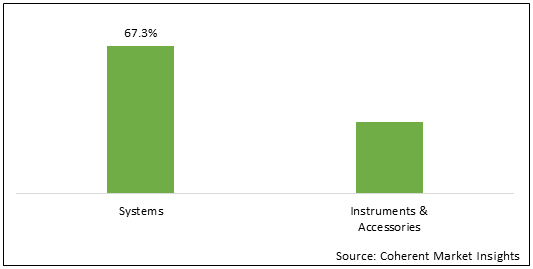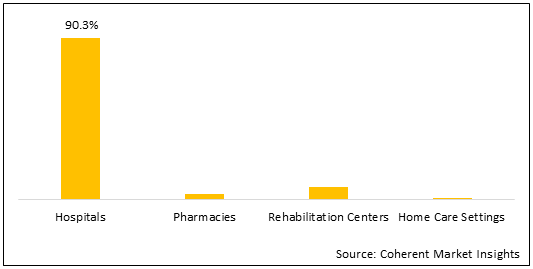Healthcare robotics aid in the improvement of patient care and results in boosting operational efficiency. Medical robots assists with streamline hospital logistics, surgery, and allow healthcare providers to pay more attention to the patients. Robots are now utilized in clinical settings to assist health personnel and improve patient care, in addition to operating rooms. Healthcare industry uses certain types of robots such as surgical robots, care robots, hospital robots, and exoskeletons in order to raise the current standard of care and to do things rapidly with minimum errors. Medical robots are most commonly used for surgical purpose. Other areas of healthcare which are starting robot application includes medical transportation, prescription dispensing, telepresence, rehabilitation, and sanitation. Robots will become more autonomous as technology advances, eventually executing certain activities fully on their own. As a result doctors, nurses, and other healthcare personnel may focus on treating patients with more empathy.
The global healthcare robotics market is estimated to be valued at US$ 9,520 million in 2021 and is expected to exhibit a CAGR of 14.8% over the forecast period (2021-2028).
Figure 1. Global Healthcare Robotics Market Share (%), By Product Type, 2021

To learn more about this report, Request sample copy
The increasing product launches and approvals are expected to drive the market growth over the forecast period.
For instance, in July 2018, Restoration Robotics, Inc., a privately held medical device company, launched ARTAS iX Robotic Hair Restoration System. This system is unique robotic intelligence solution that provides minimally invasive, repeatable harvesting, precise, and implantation features in one platform.
Healthcare Robotics Market Report Coverage
| Report Coverage | Details | ||
|---|---|---|---|
| Base Year: | 2020 | Market Size in 2021: | US$ 9,520 Mn |
| Historical Data for: | 2017 to 2020 | Forecast Period: | 2021 to 2028 |
| Forecast Period 2021 to 2028 CAGR: | 14.8% | 2028 Value Projection: | US$ 25,205 Mn |
| Geographies covered: |
|
||
| Segments covered: |
|
||
| Companies covered: |
Accuray Incorporated., Capsa Healthcare, LLC., Hocoma, Becton, Dickinson and Company, Agilent Technologies, Inc., Titan Medical, Inc., Aurora Biomed Inc., Abbott, Omnicell, Inc., F. Hoffmann-La Roche AG, Stryker Corporation, Medtronic Plc., Parata Systems LLC, avateramedical GmbH, Toyota Motor Corporation, Siemens Healthineers AG, BIONIK Laboratories Corp., THINK Surgical, Inc., Intuitive Surgical Inc., Globus Medical Inc., and Restoration Robotics, Inc. |
||
| Growth Drivers: |
|
||
| Restraints & Challenges: |
|
||
Uncover macros and micros vetted on 75+ parameters: Get instant access to report
Figure 2. Global Healthcare Robotics Market Share (%), By End User, 2021

To learn more about this report, Request sample copy
The increasing adoption of inorganic growth strategies such as mergers, collaborations, partnerships, and acquisitions by key players in order to strengthen their position in the global market is expected to drive the market growth over the forecast period.
For instance, in September 2019, Globus Medical Inc., a publicly traded medical device company, acquired most of the assets of StelKast Inc., a privately held orthopedics manufacturer company. This acquisition is expected to expand the product portfolio of Globus into total joint and arthroplasty markets.
Global Healthcare Robotics Market– Impact of Coronavirus (COVID-19) Pandemic
COVID-19 has significantly impacted almost all the industries including healthcare industry. Various countries have implemented lockdown to battle COVID-19 pandemic. This has made notable impact on manufacturing sector, as the facilities across the globe were temporarily shut down. COVID-19 pandemic has escalate the demand for medical robots in the healthcare industry. Pandemic has highlighted the importance of robotic application to avoid physical contact and to make sure sterilization, cleaning, and other support in hospitals. This will lessen life threat to the doctors and medical staff engaged in COVID-19 management. Robots are suitable to take care of patients in the current COVID-19 situation by replacing or minimizing workload of the healthcare professionals in hospitals.
Global Healthcare Robotics Market Restraint
Unforeseen mechanical failure is expected to hinder growth of the global healthcare robotics market over the forecast period. Robotic-assisted surgery poses problems same as that of open surgery, which include potential of infection, bleeding, and cardiopulmonary risks of anaesthesia. Furthermore, robotic surgery also exhibits additional and potentially fatal issues such as high surgery cost, more time required to train medical staff about robotic surgery, lack of training, and risk of mechanical failure. Robotic surgical systems have large sizes and multitude of mechanical accessories and components, which can malfunction. The system is connected to the energy source and it is prone to electric discharge, which can cause unintended internal burn injuries from the cautery device and associated accessories.
Key Players
Major players operating in the global healthcare robotics market include Accuray Incorporated., Capsa Healthcare, LLC., Hocoma, Becton, Dickinson and Company, Agilent Technologies, Inc., Titan Medical, Inc., Aurora Biomed Inc., Abbott, Omnicell, Inc., F. Hoffmann-La Roche AG, Stryker Corporation, Medtronic Plc., Parata Systems LLC, avateramedical GmbH, Toyota Motor Corporation, Siemens Healthineers AG, BIONIK Laboratories Corp., THINK Surgical, Inc., Intuitive Surgical Inc., Globus Medical Inc., and Restoration Robotics, Inc.
Share
Share
Missing comfort of reading report in your local language? Find your preferred language :
Transform your Strategy with Exclusive Trending Reports :
Frequently Asked Questions
Select a License Type

Credibility and Certifications

860519526

9001:2015
27001:2022


Joining thousands of companies around the world committed to making the Excellent Business Solutions.
View All Our Clients